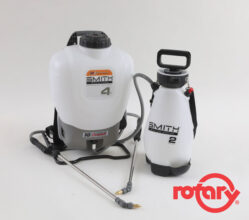Lawn Savers: Reducing thatch can minimize pests and disease
By Linda Beattie
Is your customer’s thatch a nuisance or a serious problem? Understanding how thatch collects and affects lawn growth will go a long way in determining the severity of this common problem. Thatch is a communion of dead grass, roots and other matter that builds up in grass over time. It collects on most lawns above the soil at surface level and becomes intertwined in grass stems. When the decomposition cycle is delayed for any variety of reasons, dead matter begins to build up. As the build-up increases, the matter becomes stacked, and then packs down or mats, causing healthy grass blades to become stressed, weaker and thinner. Thatch can actually choke a lawn to death. As it thickens, it robs the soil of air, and hinders water absorption and nutrient penetration to the soil and root system. Not only will excessive thatch kill the grass, but left undeterred long enough it will damage the soil so that, even if removed, new growth in that area will be sparse at best. Thick thatch levels can also become a haven for insects. Moisture-rich matted thatch can be an excellent breading ground for mosquitos and disease. Talking to your customer about the level of thatch and the size of the area affected will assist you in helping that person to properly combat the problem.
Nuisance thatch
A thin layer of thatch, up to 1/4 inch, is common and easily controlled with a dethatcher. Also known as turf rakes or power rakes, dethatchers grapple at the soil surface, lifting dead matter to the top of the lawn, so it can be removed. Dethatchers are offered in many styles.
Handheld units use layers of pliable steel combs that lift thatch to the surface. These units are ample and very effective for smaller lawns. Handhelds are lightweight and easy to maneuver.
Walk-behind dethatchers are larger and more powerful for use on medium to large properties. The most common blades for walk-behind dethatchers are flail blades. Flail blades, although not pliable, are individually mounted to the reel loosely so that each blade can move freely and dangle from the reel. The thrusting of the blades traveling around the reel easily combs through grass to lift thatch with enough force that the thatch can be thrown into a catcher bag to the rear of the machine for quick removal and disposal. Since dethatching isn’t a task done every weekend, the equipment makes for a very popular rental item.
Moderate thatch
When thatch levels reach 1/4 inch to about 1/2 inch, your customer has a moderate thatch problem. By definition, dethatchers only “scratch the surface.” By this time, the problem may have affected the upper soil level. Dethatching will help control the problem, although odds are — even if dethatched thoroughly at this point there will be bare spots left behind and the remaining grass in the area affected will be sparse and weak. Dethatching followed by seeding and fertilizing may be remedy enough for the soil and help the lawn recover.
Excessive thatch
If the customer’s thatch is 1/2 inch thick or higher and any new growth is weak and sparse, the root system is being compromised. In time, thatch will compact the soil and suffocate the root system. Soil aeration will be needed to loosen the soil to allow air, water and nutrients to penetrate the soil’s root system. A core aerator (an aerator that drops soil plugs on the surface of the lawn), would offer the starved soil much-needed nutrients as it decomposes, and will also increase thatch decomposition.
Thatch creates a water barrier, prevents new grass from growing, and harbors insects. It collects quickly, and, before long, the lawn and its entire root system is at risk. Talk to your customers about the importance of good lawn-maintenance practices. Lawn dethatching, when performed as needed, will go a long way in maintaining a healthy, green lawn.
Linda Beattie is commercial public relations, marketing and sales support for Little Wonder, Mantis, Classen, Bob-Cat, Bunton, Ryan and Steiner.


